Home / Monochlorination Products Of Propane, Pentane, And Other Alkanes
Free Radical Reactions
Monochlorination Products Of Propane, Pentane, And Other Alkanes
Last updated: November 8th, 2024 |
How Many Monochlorination Isomers Are Formed From Free-Radical Chlorination Of Alkanes?
Last time we covered a comparatively simple reaction: free-radical chlorination of methane to (CH4) to give chloromethane (CH3Cl) and saw that the reaction proceeds through three stages – initiation (where free radicals are created), propagation (the main “product-forming” step of the chain reaction, where a chloroalkane is created without net formation of new free radicals) and termination (where radicals combine, resulting in a net reduction of the number of free radicals).
There’s one simple extension of this reaction I’d like to cover in this post. We just covered the simple molecule CH4. What happens when we move beyond CH4 to the monochlorination of more complex alkanes?
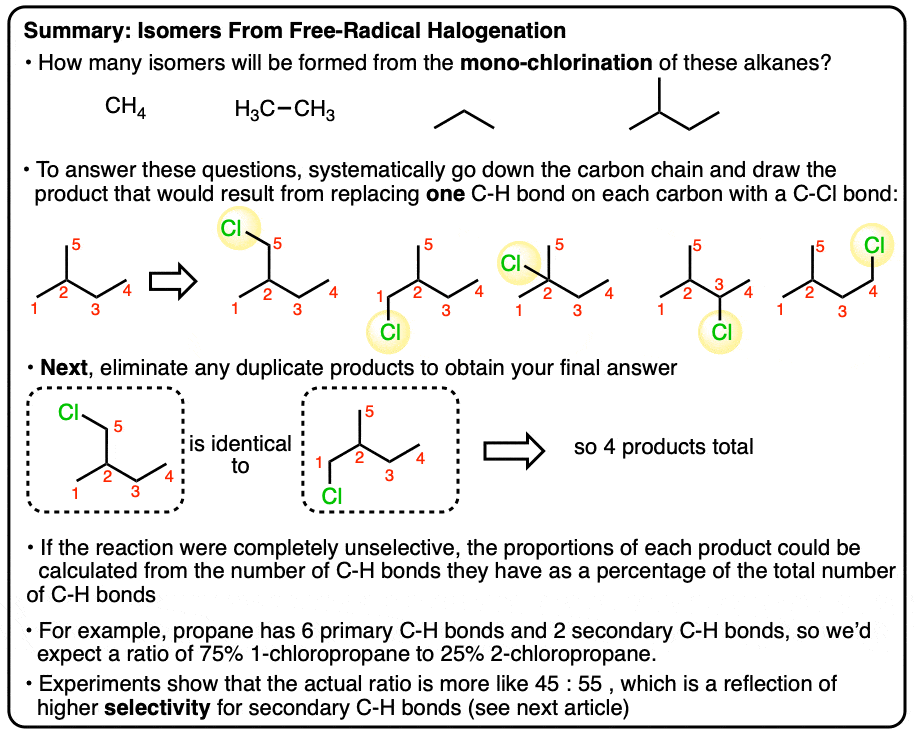
Table Of Contents
- Free-Radical Halogenation Of Methane And Ethane Can Only Give One Mono-Chlorinated Product
- How Many Mono-Chlorinated Isomers Are Formed From Propane?
- A More Complex Example: Monochlorination of Pentane
- The Case of 2-Methylpentane
- If Chlorination Were Completely Random, What Yields Of 1-Chloropropane and 2-Chloropropane Would We Expect To See?
- Test Yourself
- Notes
- (Advanced) References and Further Reading
1. Free Radical Halogenation Of Methane And Ethane Can Give Only One Monochlorinated Product
In the last post we discussed mono-chlorination of methane. It’s easy to talk about this reaction since all the hydrogens are equal. No matter which hydrogen you replace, you get the same product (CH3Cl).
Likewise, mono-chlorination of ethane also gives just one product: chloroethane.
(We can say that the hydrogens in methane and ethane are “homotopic“, but that’s a discussion for another day).
What about more complicated cases, like propane, butane, pentane, or even 2-methylpentane?
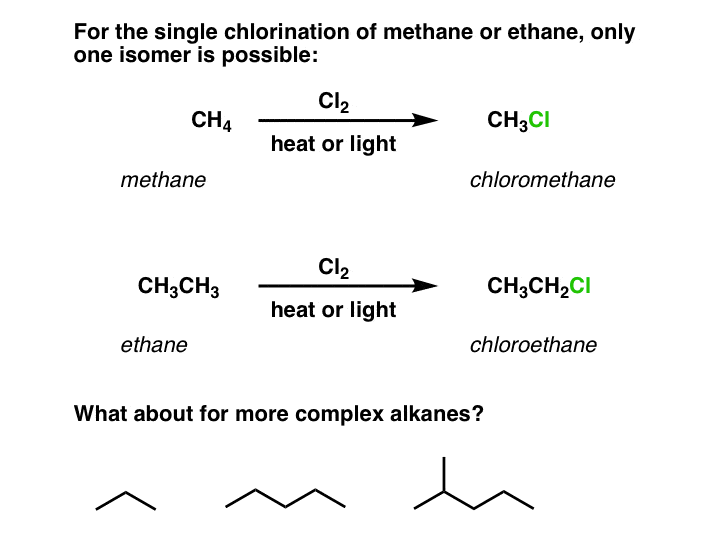
2. How Many Monochlorinated Isomers Are Formed From Propane?
Let’s start with propane. The first step here, if it isn’t immediately obvious, is to be aware of the “hidden” or “implicit” hydrogens on the line diagrams shown above – it’s important to be able to expand out a line diagram to a condensed formula.
The next step is to go about drawing the various possibilities as we replace a single hydrogen on propane with chlorine. For propane, hopefully it should be clear that there are only two possiblities: chlorination at C-1 or C-2 (chlorination at C-3 would give the same product as that at C-1).
These two products (1-chloropropane and 2-chloropropane) are constitutional isomers.
[Question to think about: If the chlorination of propane was completely random, what yields of 1-chloropropane and 2-chloropropane would you expect to see? Answer below]
3. A More Complex Example: Monochlorination of Pentane
Similarly, what do we get for the slightly more complicated example of pentane? There’s no mathematical formula for figuring this out, but as with many things in organic chemistry, it can pay dividends to be systematic. Start at one end and work towards the other. One thing that can help is applying IUPAC nomenclature to each possibility – it can assist in realizing if you’ve drawn a duplicate.

We have 3 possibilities for constitutional isomers: 1-chloropentane, 2-chloropentane, and 3-chloropentane.
[note that I said “constitutional isomers” – can you see possibilities for stereoisomers in any of these molecules? [Note 1]
4. Monochlorination Of 2-Methylpentane
Finally let’s look at another slightly more complex example: 2-methylpentane.
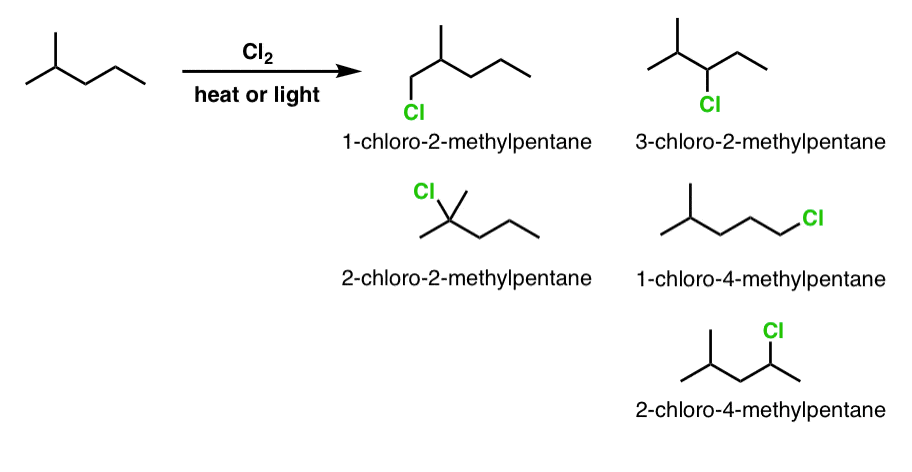
Here, we have 5 constitutional isomers possible (not counting stereoisomers). Again, it helps to break out your IUPAC nomenclature to double-check that there are no duplicates.
It is impossible to capture the variety of potential questions with these three examples, but the general thrust is the same. It also helps to have a systematic approach – starting the exchange of hydrogen for chlorine at one side of the molecule, and gradually working to the other side.
5. If Chlorination Was Completely Random, What Yields Of 1-Chloropropane and 2-Chloropropane Would We Expect To See?
Question answer: If the chlorination of propane was completely random, what yields of 1-propane and 2-propane would you expect to see?
Well, there’s 6 methyl hydrogens, and 2 “methylene” (CH2) hydrogens. So you’d expect to see a ratio of 75% 1-chloropropane to 25% 2-chloropropane.
Is that what’s observed? No!
Instead, experiments show that free-radical chlorination of propane in the gas phase at 25°C give 45% 1-chloropropane to 55% 2-chloropropane!
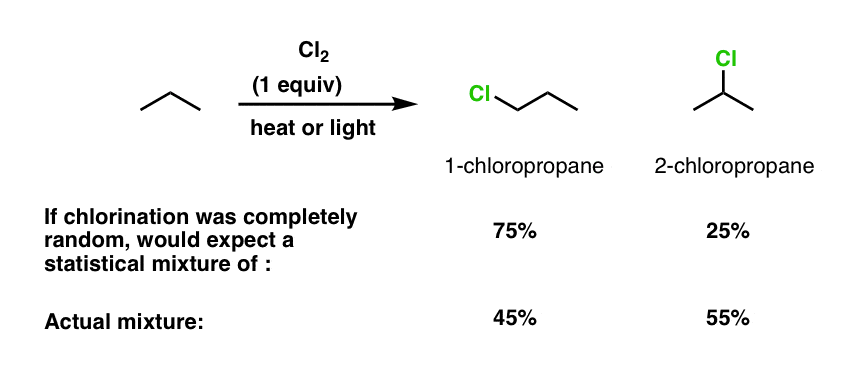
Why that might be? We’ll talk about that in the next post.
6. Test Yourself on Monochlorination of Alkanes
Here’s some more practice problems. How many constitutional isomers would you expect to see for the mono-chlorination of each of these molecules?
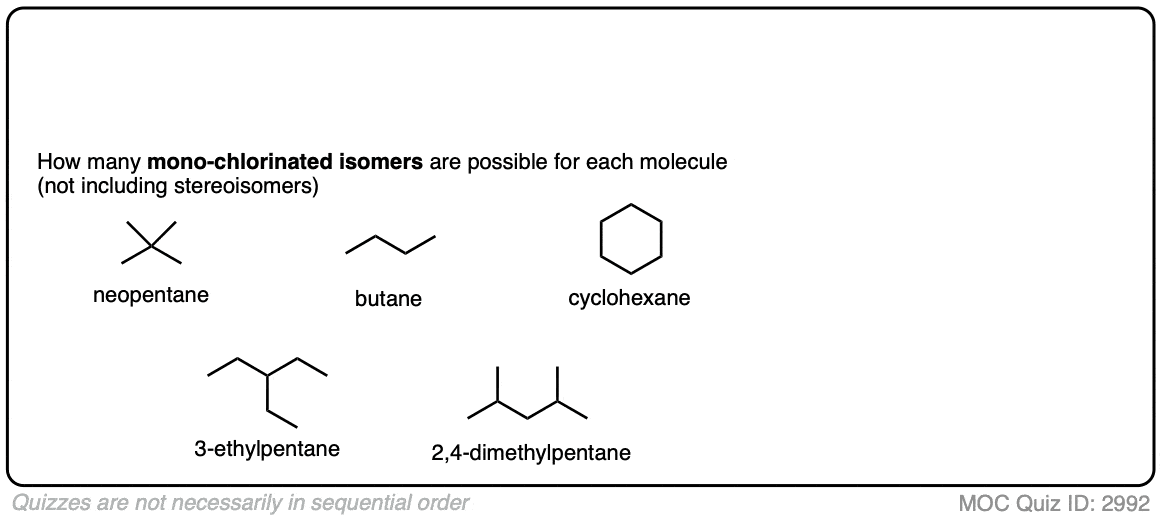 Click to Flip
Click to Flip
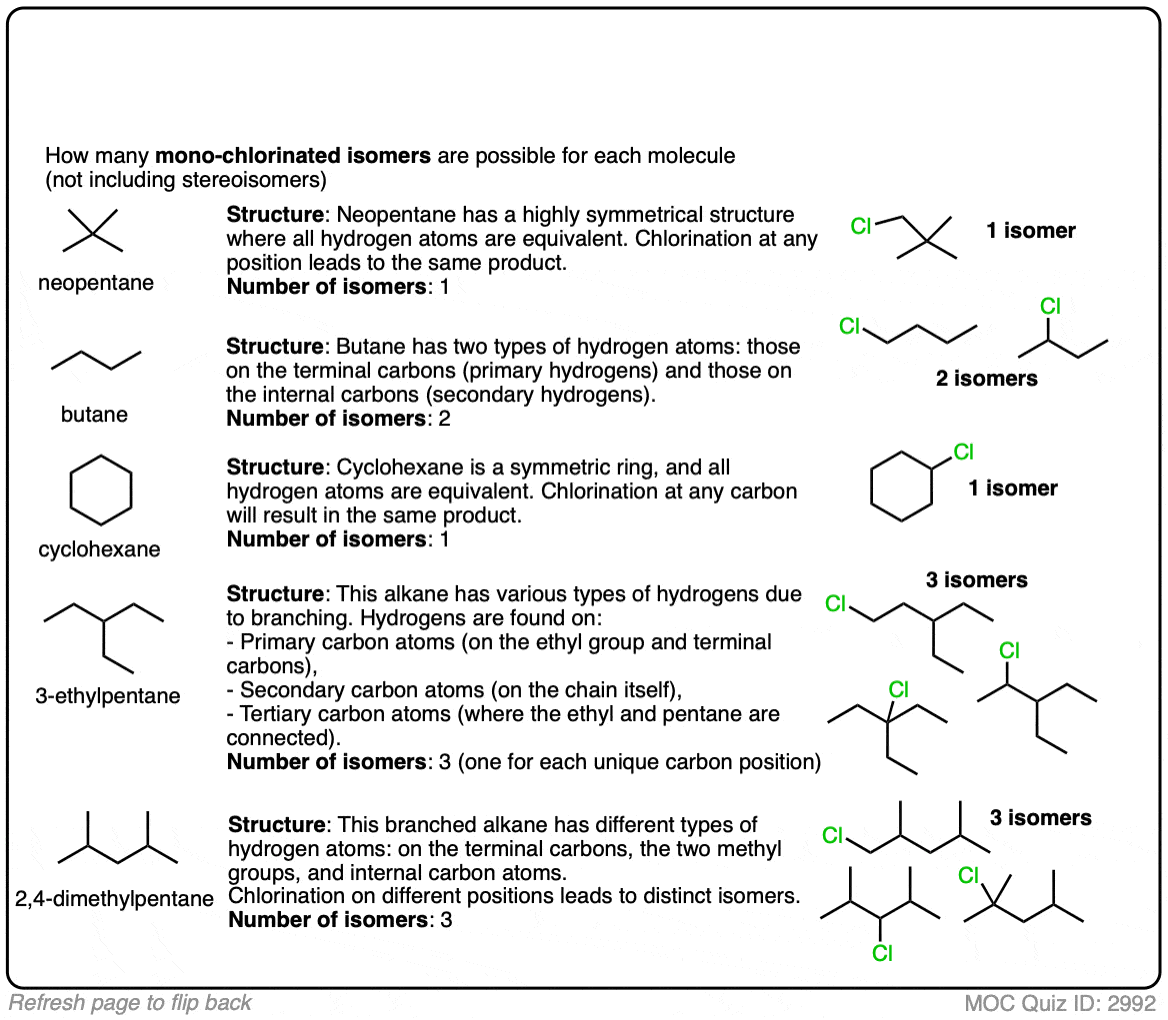
Next Post: Selectivity In Free Radical Reactions
Notes
Related Articles
- Selectivity in Free Radical Reactions: Bromination vs. Chlorination
- Selectivity In Free Radical Reactions
- Free Radical Bromination of Alkanes (MOC Membership)
- Free Radical Chlorination of Alkanes (MOC Membership)
- In Summary: Free Radicals
- Homotopic, Enantiotopic, Diastereotopic
- Free Radicals Practice Quizzes (MOC Membership required)
Note 1. Hopefully you can see that 2-chloropentane has a chiral center, so can exist as either (R)-2-chloropentane or (S)-2-chloropentane. Under free radical conditions we will obtain a racemic mixture of these two compounds (i.e. 50% mixture of (R) and (S).
(Advanced) References and Further Reading
- Syntheses from Natural Gas Hydrocarbons Identity of Monochlorides from Chlorination of Simpler Paraffins
B. Hass, E. T. McBee, and Paul Weber
Industrial & Engineering Chemistry 1935, 27 (10), 1190-1195
DOI: 10.1021/ie50310a025
The source of the 41:59 ratio of 1-chloropropane to 2-chloropropane for the chlorination of propane is from this 1935 paper, the first in a series of rigorous studies on the halogenation of simple alkanes (paraffins) under both free-radical and thermal conditions. One notable advance of Hass’ work here was in obtaining pure standards for each of the monochlorination products, so that their physical properties could be measured and the yields of the reactions accurately reported. - Chlorination of Paraffins
B. Hass, E. T. McBee, and Paul Weber
Industrial & Engineering Chemistry 1936, 28 (3), 333-339
DOI: 10.1021/ie50315a017
The above two papers contain what is now known as “Hass’ rules for radical chlorination”. The first five of these rules are summarized below:
1. If the temperature is controlled to prevent pyrolysis, no skeletal rearrangements will occur, and every possible monochloride will form.
2. The rate of substitution of hydrogen atoms is in the order tertiary > secondary > primary
3. As temperature increases, selectivity of chlorination decreases (it approaches 1:1:1 (tertiary:secondary:primary))
4. Liquid phase chlorination is less selective than gas-phase chlorination
5. Once initiated, chlorination is unaffected by moisture, light, and ‘carbon surfaces’
Pyrolysis is the decomposition of organic materials at high temperatures, usually at 430 °C or higher. The reason for Rule #4 is that the reaction is 2nd order and is dependent on the concentration of both methane and chlorine. The liquid phase, being a condensed phase, is much more concentrated than the gas phase.The paper also calculates a relative reaction rate of 4.43 : 3.25 : 1.00 for the chlorination of tertiary, secondary, and primary C-H bonds, respectively, for a reaction at 300°C in the vapor phase. - Chlorination of Methane
T. McBee, H. B. Hass, C. M. Neher, and H. Strickland
Industrial & Engineering Chemistry 1942, 34 (3), 296-300
DOI: 10.1021/ie50387a009
This paper shows the design of a reactor for the chlorination of methane such that the reaction can be controlled to give any of the desired chloromethanes in high yield. This is of significance because CH3Cl, CH2Cl2, CHCl3, and CCl4 are all important feedstocks or solvents and this is how they are produced industrially. - KINETICS OF THE THERMAL CHLORINATION OF METHANE
Robert N. Pease and George F. Walz
Journal of the American Chemical Society 1931, 53 (10), 3728-3737
DOI: 10.1021/ja01361a016
This paper provides kinetic evidence that chlorination of methane is 2nd order (first order in both methane and Cl2).
00 General Chemistry Review
01 Bonding, Structure, and Resonance
- How Do We Know Methane (CH4) Is Tetrahedral?
- Hybrid Orbitals and Hybridization
- How To Determine Hybridization: A Shortcut
- Orbital Hybridization And Bond Strengths
- Sigma bonds come in six varieties: Pi bonds come in one
- A Key Skill: How to Calculate Formal Charge
- The Four Intermolecular Forces and How They Affect Boiling Points
- 3 Trends That Affect Boiling Points
- How To Use Electronegativity To Determine Electron Density (and why NOT to trust formal charge)
- Introduction to Resonance
- How To Use Curved Arrows To Interchange Resonance Forms
- Evaluating Resonance Forms (1) - The Rule of Least Charges
- How To Find The Best Resonance Structure By Applying Electronegativity
- Evaluating Resonance Structures With Negative Charges
- Evaluating Resonance Structures With Positive Charge
- Exploring Resonance: Pi-Donation
- Exploring Resonance: Pi-acceptors
- In Summary: Evaluating Resonance Structures
- Drawing Resonance Structures: 3 Common Mistakes To Avoid
- How to apply electronegativity and resonance to understand reactivity
- Bond Hybridization Practice
- Structure and Bonding Practice Quizzes
- Resonance Structures Practice
02 Acid Base Reactions
- Introduction to Acid-Base Reactions
- Acid Base Reactions In Organic Chemistry
- The Stronger The Acid, The Weaker The Conjugate Base
- Walkthrough of Acid-Base Reactions (3) - Acidity Trends
- Five Key Factors That Influence Acidity
- Acid-Base Reactions: Introducing Ka and pKa
- How to Use a pKa Table
- The pKa Table Is Your Friend
- A Handy Rule of Thumb for Acid-Base Reactions
- Acid Base Reactions Are Fast
- pKa Values Span 60 Orders Of Magnitude
- How Protonation and Deprotonation Affect Reactivity
- Acid Base Practice Problems
03 Alkanes and Nomenclature
- Meet the (Most Important) Functional Groups
- Condensed Formulas: Deciphering What the Brackets Mean
- Hidden Hydrogens, Hidden Lone Pairs, Hidden Counterions
- Don't Be Futyl, Learn The Butyls
- Primary, Secondary, Tertiary, Quaternary In Organic Chemistry
- Branching, and Its Affect On Melting and Boiling Points
- The Many, Many Ways of Drawing Butane
- Wedge And Dash Convention For Tetrahedral Carbon
- Common Mistakes in Organic Chemistry: Pentavalent Carbon
- Table of Functional Group Priorities for Nomenclature
- Summary Sheet - Alkane Nomenclature
- Organic Chemistry IUPAC Nomenclature Demystified With A Simple Puzzle Piece Approach
- Boiling Point Quizzes
- Organic Chemistry Nomenclature Quizzes
04 Conformations and Cycloalkanes
- Staggered vs Eclipsed Conformations of Ethane
- Conformational Isomers of Propane
- Newman Projection of Butane (and Gauche Conformation)
- Introduction to Cycloalkanes
- Geometric Isomers In Small Rings: Cis And Trans Cycloalkanes
- Calculation of Ring Strain In Cycloalkanes
- Cycloalkanes - Ring Strain In Cyclopropane And Cyclobutane
- Cyclohexane Conformations
- Cyclohexane Chair Conformation: An Aerial Tour
- How To Draw The Cyclohexane Chair Conformation
- The Cyclohexane Chair Flip
- The Cyclohexane Chair Flip - Energy Diagram
- Substituted Cyclohexanes - Axial vs Equatorial
- Ranking The Bulkiness Of Substituents On Cyclohexanes: "A-Values"
- Cyclohexane Chair Conformation Stability: Which One Is Lower Energy?
- Fused Rings - Cis-Decalin and Trans-Decalin
- Naming Bicyclic Compounds - Fused, Bridged, and Spiro
- Bredt's Rule (And Summary of Cycloalkanes)
- Newman Projection Practice
- Cycloalkanes Practice Problems
05 A Primer On Organic Reactions
- The Most Important Question To Ask When Learning a New Reaction
- Curved Arrows (for reactions)
- Nucleophiles and Electrophiles
- The Three Classes of Nucleophiles
- Nucleophilicity vs. Basicity
- What Makes A Good Nucleophile?
- What Makes A Good Leaving Group?
- 3 Factors That Stabilize Carbocations
- Equilibrium and Energy Relationships
- 7 Factors that stabilize negative charge in organic chemistry
- 7 Factors That Stabilize Positive Charge in Organic Chemistry
- What's a Transition State?
- Hammond's Postulate
- Learning Organic Chemistry Reactions: A Checklist (PDF)
- Introduction to Oxidative Cleavage Reactions
06 Free Radical Reactions
- Free Radical Reactions
- 3 Factors That Stabilize Free Radicals
- Bond Strengths And Radical Stability
- Free Radical Initiation: Why Is "Light" Or "Heat" Required?
- Initiation, Propagation, Termination
- Monochlorination Products Of Propane, Pentane, And Other Alkanes
- Selectivity In Free Radical Reactions
- Selectivity in Free Radical Reactions: Bromination vs. Chlorination
- Halogenation At Tiffany's
- Allylic Bromination
- Bonus Topic: Allylic Rearrangements
- In Summary: Free Radicals
- Synthesis (2) - Reactions of Alkanes
- Free Radicals Practice Quizzes
07 Stereochemistry and Chirality
- Types of Isomers: Constitutional Isomers, Stereoisomers, Enantiomers, and Diastereomers
- How To Draw The Enantiomer Of A Chiral Molecule
- How To Draw A Bond Rotation
- Introduction to Assigning (R) and (S): The Cahn-Ingold-Prelog Rules
- Assigning Cahn-Ingold-Prelog (CIP) Priorities (2) - The Method of Dots
- Enantiomers vs Diastereomers vs The Same? Two Methods For Solving Problems
- Assigning R/S To Newman Projections (And Converting Newman To Line Diagrams)
- How To Determine R and S Configurations On A Fischer Projection
- The Meso Trap
- Optical Rotation, Optical Activity, and Specific Rotation
- Optical Purity and Enantiomeric Excess
- What's a Racemic Mixture?
- Chiral Allenes And Chiral Axes
- Stereochemistry Practice Problems and Quizzes
08 Substitution Reactions
- Nucleophilic Substitution Reactions - Introduction
- Two Types of Nucleophilic Substitution Reactions
- The SN2 Mechanism
- Why the SN2 Reaction Is Powerful
- The SN1 Mechanism
- The Conjugate Acid Is A Better Leaving Group
- Comparing the SN1 and SN2 Reactions
- Polar Protic? Polar Aprotic? Nonpolar? All About Solvents
- Steric Hindrance is Like a Fat Goalie
- Common Blind Spot: Intramolecular Reactions
- Substitution Practice - SN1
- Substitution Practice - SN2
09 Elimination Reactions
- Elimination Reactions (1): Introduction And The Key Pattern
- Elimination Reactions (2): The Zaitsev Rule
- Elimination Reactions Are Favored By Heat
- Two Elimination Reaction Patterns
- The E1 Reaction
- The E2 Mechanism
- E1 vs E2: Comparing the E1 and E2 Reactions
- Antiperiplanar Relationships: The E2 Reaction and Cyclohexane Rings
- Bulky Bases in Elimination Reactions
- Comparing the E1 vs SN1 Reactions
- Elimination (E1) Reactions With Rearrangements
- E1cB - Elimination (Unimolecular) Conjugate Base
- Elimination (E1) Practice Problems And Solutions
- Elimination (E2) Practice Problems and Solutions
10 Rearrangements
11 SN1/SN2/E1/E2 Decision
- Identifying Where Substitution and Elimination Reactions Happen
- Deciding SN1/SN2/E1/E2 (1) - The Substrate
- Deciding SN1/SN2/E1/E2 (2) - The Nucleophile/Base
- SN1 vs E1 and SN2 vs E2 : The Temperature
- Deciding SN1/SN2/E1/E2 - The Solvent
- Wrapup: The Key Factors For Determining SN1/SN2/E1/E2
- Alkyl Halide Reaction Map And Summary
- SN1 SN2 E1 E2 Practice Problems
12 Alkene Reactions
- E and Z Notation For Alkenes (+ Cis/Trans)
- Alkene Stability
- Alkene Addition Reactions: "Regioselectivity" and "Stereoselectivity" (Syn/Anti)
- Stereoselective and Stereospecific Reactions
- Hydrohalogenation of Alkenes and Markovnikov's Rule
- Hydration of Alkenes With Aqueous Acid
- Rearrangements in Alkene Addition Reactions
- Halogenation of Alkenes and Halohydrin Formation
- Oxymercuration Demercuration of Alkenes
- Hydroboration Oxidation of Alkenes
- m-CPBA (meta-chloroperoxybenzoic acid)
- OsO4 (Osmium Tetroxide) for Dihydroxylation of Alkenes
- Palladium on Carbon (Pd/C) for Catalytic Hydrogenation of Alkenes
- Cyclopropanation of Alkenes
- A Fourth Alkene Addition Pattern - Free Radical Addition
- Alkene Reactions: Ozonolysis
- Summary: Three Key Families Of Alkene Reaction Mechanisms
- Synthesis (4) - Alkene Reaction Map, Including Alkyl Halide Reactions
- Alkene Reactions Practice Problems
13 Alkyne Reactions
- Acetylides from Alkynes, And Substitution Reactions of Acetylides
- Partial Reduction of Alkynes With Lindlar's Catalyst
- Partial Reduction of Alkynes With Na/NH3 To Obtain Trans Alkenes
- Alkyne Hydroboration With "R2BH"
- Hydration and Oxymercuration of Alkynes
- Hydrohalogenation of Alkynes
- Alkyne Halogenation: Bromination and Chlorination of Alkynes
- Oxidation of Alkynes With O3 and KMnO4
- Alkenes To Alkynes Via Halogenation And Elimination Reactions
- Alkynes Are A Blank Canvas
- Synthesis (5) - Reactions of Alkynes
- Alkyne Reactions Practice Problems With Answers
14 Alcohols, Epoxides and Ethers
- Alcohols - Nomenclature and Properties
- Alcohols Can Act As Acids Or Bases (And Why It Matters)
- Alcohols - Acidity and Basicity
- The Williamson Ether Synthesis
- Ethers From Alkenes, Tertiary Alkyl Halides and Alkoxymercuration
- Alcohols To Ethers via Acid Catalysis
- Cleavage Of Ethers With Acid
- Epoxides - The Outlier Of The Ether Family
- Opening of Epoxides With Acid
- Epoxide Ring Opening With Base
- Making Alkyl Halides From Alcohols
- Tosylates And Mesylates
- PBr3 and SOCl2
- Elimination Reactions of Alcohols
- Elimination of Alcohols To Alkenes With POCl3
- Alcohol Oxidation: "Strong" and "Weak" Oxidants
- Demystifying The Mechanisms of Alcohol Oxidations
- Protecting Groups For Alcohols
- Thiols And Thioethers
- Calculating the oxidation state of a carbon
- Oxidation and Reduction in Organic Chemistry
- Oxidation Ladders
- SOCl2 Mechanism For Alcohols To Alkyl Halides: SN2 versus SNi
- Alcohol Reactions Roadmap (PDF)
- Alcohol Reaction Practice Problems
- Epoxide Reaction Quizzes
- Oxidation and Reduction Practice Quizzes
15 Organometallics
- What's An Organometallic?
- Formation of Grignard and Organolithium Reagents
- Organometallics Are Strong Bases
- Reactions of Grignard Reagents
- Protecting Groups In Grignard Reactions
- Synthesis Problems Involving Grignard Reagents
- Grignard Reactions And Synthesis (2)
- Organocuprates (Gilman Reagents): How They're Made
- Gilman Reagents (Organocuprates): What They're Used For
- The Heck, Suzuki, and Olefin Metathesis Reactions (And Why They Don't Belong In Most Introductory Organic Chemistry Courses)
- Reaction Map: Reactions of Organometallics
- Grignard Practice Problems
16 Spectroscopy
- Degrees of Unsaturation (or IHD, Index of Hydrogen Deficiency)
- Conjugation And Color (+ How Bleach Works)
- Introduction To UV-Vis Spectroscopy
- UV-Vis Spectroscopy: Absorbance of Carbonyls
- UV-Vis Spectroscopy: Practice Questions
- Bond Vibrations, Infrared Spectroscopy, and the "Ball and Spring" Model
- Infrared Spectroscopy: A Quick Primer On Interpreting Spectra
- IR Spectroscopy: 4 Practice Problems
- 1H NMR: How Many Signals?
- Homotopic, Enantiotopic, Diastereotopic
- Diastereotopic Protons in 1H NMR Spectroscopy: Examples
- 13-C NMR - How Many Signals
- Liquid Gold: Pheromones In Doe Urine
- Natural Product Isolation (1) - Extraction
- Natural Product Isolation (2) - Purification Techniques, An Overview
- Structure Determination Case Study: Deer Tarsal Gland Pheromone
17 Dienes and MO Theory
- What To Expect In Organic Chemistry 2
- Are these molecules conjugated?
- Conjugation And Resonance In Organic Chemistry
- Bonding And Antibonding Pi Orbitals
- Molecular Orbitals of The Allyl Cation, Allyl Radical, and Allyl Anion
- Pi Molecular Orbitals of Butadiene
- Reactions of Dienes: 1,2 and 1,4 Addition
- Thermodynamic and Kinetic Products
- More On 1,2 and 1,4 Additions To Dienes
- s-cis and s-trans
- The Diels-Alder Reaction
- Cyclic Dienes and Dienophiles in the Diels-Alder Reaction
- Stereochemistry of the Diels-Alder Reaction
- Exo vs Endo Products In The Diels Alder: How To Tell Them Apart
- HOMO and LUMO In the Diels Alder Reaction
- Why Are Endo vs Exo Products Favored in the Diels-Alder Reaction?
- Diels-Alder Reaction: Kinetic and Thermodynamic Control
- The Retro Diels-Alder Reaction
- The Intramolecular Diels Alder Reaction
- Regiochemistry In The Diels-Alder Reaction
- The Cope and Claisen Rearrangements
- Electrocyclic Reactions
- Electrocyclic Ring Opening And Closure (2) - Six (or Eight) Pi Electrons
- Diels Alder Practice Problems
- Molecular Orbital Theory Practice
18 Aromaticity
- Introduction To Aromaticity
- Rules For Aromaticity
- Huckel's Rule: What Does 4n+2 Mean?
- Aromatic, Non-Aromatic, or Antiaromatic? Some Practice Problems
- Antiaromatic Compounds and Antiaromaticity
- The Pi Molecular Orbitals of Benzene
- The Pi Molecular Orbitals of Cyclobutadiene
- Frost Circles
- Aromaticity Practice Quizzes
19 Reactions of Aromatic Molecules
- Electrophilic Aromatic Substitution: Introduction
- Activating and Deactivating Groups In Electrophilic Aromatic Substitution
- Electrophilic Aromatic Substitution - The Mechanism
- Ortho-, Para- and Meta- Directors in Electrophilic Aromatic Substitution
- Understanding Ortho, Para, and Meta Directors
- Why are halogens ortho- para- directors?
- Disubstituted Benzenes: The Strongest Electron-Donor "Wins"
- Electrophilic Aromatic Substitutions (1) - Halogenation of Benzene
- Electrophilic Aromatic Substitutions (2) - Nitration and Sulfonation
- EAS Reactions (3) - Friedel-Crafts Acylation and Friedel-Crafts Alkylation
- Intramolecular Friedel-Crafts Reactions
- Nucleophilic Aromatic Substitution (NAS)
- Nucleophilic Aromatic Substitution (2) - The Benzyne Mechanism
- Reactions on the "Benzylic" Carbon: Bromination And Oxidation
- The Wolff-Kishner, Clemmensen, And Other Carbonyl Reductions
- More Reactions on the Aromatic Sidechain: Reduction of Nitro Groups and the Baeyer Villiger
- Aromatic Synthesis (1) - "Order Of Operations"
- Synthesis of Benzene Derivatives (2) - Polarity Reversal
- Aromatic Synthesis (3) - Sulfonyl Blocking Groups
- Birch Reduction
- Synthesis (7): Reaction Map of Benzene and Related Aromatic Compounds
- Aromatic Reactions and Synthesis Practice
- Electrophilic Aromatic Substitution Practice Problems
20 Aldehydes and Ketones
- What's The Alpha Carbon In Carbonyl Compounds?
- Nucleophilic Addition To Carbonyls
- Aldehydes and Ketones: 14 Reactions With The Same Mechanism
- Sodium Borohydride (NaBH4) Reduction of Aldehydes and Ketones
- Grignard Reagents For Addition To Aldehydes and Ketones
- Wittig Reaction
- Hydrates, Hemiacetals, and Acetals
- Imines - Properties, Formation, Reactions, and Mechanisms
- All About Enamines
- Breaking Down Carbonyl Reaction Mechanisms: Reactions of Anionic Nucleophiles (Part 2)
- Aldehydes Ketones Reaction Practice
21 Carboxylic Acid Derivatives
- Nucleophilic Acyl Substitution (With Negatively Charged Nucleophiles)
- Addition-Elimination Mechanisms With Neutral Nucleophiles (Including Acid Catalysis)
- Basic Hydrolysis of Esters - Saponification
- Transesterification
- Proton Transfer
- Fischer Esterification - Carboxylic Acid to Ester Under Acidic Conditions
- Lithium Aluminum Hydride (LiAlH4) For Reduction of Carboxylic Acid Derivatives
- LiAlH[Ot-Bu]3 For The Reduction of Acid Halides To Aldehydes
- Di-isobutyl Aluminum Hydride (DIBAL) For The Partial Reduction of Esters and Nitriles
- Amide Hydrolysis
- Thionyl Chloride (SOCl2) And Conversion of Carboxylic Acids to Acid Halides
- Diazomethane (CH2N2)
- Carbonyl Chemistry: Learn Six Mechanisms For the Price Of One
- Making Music With Mechanisms (PADPED)
- Carboxylic Acid Derivatives Practice Questions
22 Enols and Enolates
- Keto-Enol Tautomerism
- Enolates - Formation, Stability, and Simple Reactions
- Kinetic Versus Thermodynamic Enolates
- Aldol Addition and Condensation Reactions
- Reactions of Enols - Acid-Catalyzed Aldol, Halogenation, and Mannich Reactions
- Claisen Condensation and Dieckmann Condensation
- Decarboxylation
- The Malonic Ester and Acetoacetic Ester Synthesis
- The Michael Addition Reaction and Conjugate Addition
- The Robinson Annulation
- Haloform Reaction
- The Hell–Volhard–Zelinsky Reaction
- Enols and Enolates Practice Quizzes
23 Amines
- The Amide Functional Group: Properties, Synthesis, and Nomenclature
- Basicity of Amines And pKaH
- 5 Key Basicity Trends of Amines
- The Mesomeric Effect And Aromatic Amines
- Nucleophilicity of Amines
- Alkylation of Amines (Sucks!)
- Reductive Amination
- The Gabriel Synthesis
- Some Reactions of Azides
- The Hofmann Elimination
- The Hofmann and Curtius Rearrangements
- The Cope Elimination
- Protecting Groups for Amines - Carbamates
- The Strecker Synthesis of Amino Acids
- Introduction to Peptide Synthesis
- Reactions of Diazonium Salts: Sandmeyer and Related Reactions
- Amine Practice Questions
24 Carbohydrates
- D and L Notation For Sugars
- Pyranoses and Furanoses: Ring-Chain Tautomerism In Sugars
- What is Mutarotation?
- Reducing Sugars
- The Big Damn Post Of Carbohydrate-Related Chemistry Definitions
- The Haworth Projection
- Converting a Fischer Projection To A Haworth (And Vice Versa)
- Reactions of Sugars: Glycosylation and Protection
- The Ruff Degradation and Kiliani-Fischer Synthesis
- Isoelectric Points of Amino Acids (and How To Calculate Them)
- Carbohydrates Practice
- Amino Acid Quizzes
25 Fun and Miscellaneous
- A Gallery of Some Interesting Molecules From Nature
- Screw Organic Chemistry, I'm Just Going To Write About Cats
- On Cats, Part 1: Conformations and Configurations
- On Cats, Part 2: Cat Line Diagrams
- On Cats, Part 4: Enantiocats
- On Cats, Part 6: Stereocenters
- Organic Chemistry Is Shit
- The Organic Chemistry Behind "The Pill"
- Maybe they should call them, "Formal Wins" ?
- Why Do Organic Chemists Use Kilocalories?
- The Principle of Least Effort
- Organic Chemistry GIFS - Resonance Forms
- Reproducibility In Organic Chemistry
- What Holds The Nucleus Together?
- How Reactions Are Like Music
- Organic Chemistry and the New MCAT
26 Organic Chemistry Tips and Tricks
- Common Mistakes: Formal Charges Can Mislead
- Partial Charges Give Clues About Electron Flow
- Draw The Ugly Version First
- Organic Chemistry Study Tips: Learn the Trends
- The 8 Types of Arrows In Organic Chemistry, Explained
- Top 10 Skills To Master Before An Organic Chemistry 2 Final
- Common Mistakes with Carbonyls: Carboxylic Acids... Are Acids!
- Planning Organic Synthesis With "Reaction Maps"
- Alkene Addition Pattern #1: The "Carbocation Pathway"
- Alkene Addition Pattern #2: The "Three-Membered Ring" Pathway
- Alkene Addition Pattern #3: The "Concerted" Pathway
- Number Your Carbons!
- The 4 Major Classes of Reactions in Org 1
- How (and why) electrons flow
- Grossman's Rule
- Three Exam Tips
- A 3-Step Method For Thinking Through Synthesis Problems
- Putting It Together
- Putting Diels-Alder Products in Perspective
- The Ups and Downs of Cyclohexanes
- The Most Annoying Exceptions in Org 1 (Part 1)
- The Most Annoying Exceptions in Org 1 (Part 2)
- The Marriage May Be Bad, But the Divorce Still Costs Money
- 9 Nomenclature Conventions To Know
- Nucleophile attacks Electrophile
27 Case Studies of Successful O-Chem Students
- Success Stories: How Corina Got The The "Hard" Professor - And Got An A+ Anyway
- How Helena Aced Organic Chemistry
- From a "Drop" To B+ in Org 2 – How A Hard Working Student Turned It Around
- How Serge Aced Organic Chemistry
- Success Stories: How Zach Aced Organic Chemistry 1
- Success Stories: How Kari Went From C– to B+
- How Esther Bounced Back From a "C" To Get A's In Organic Chemistry 1 And 2
- How Tyrell Got The Highest Grade In Her Organic Chemistry Course
- This Is Why Students Use Flashcards
- Success Stories: How Stu Aced Organic Chemistry
- How John Pulled Up His Organic Chemistry Exam Grades
- Success Stories: How Nathan Aced Organic Chemistry (Without It Taking Over His Life)
- How Chris Aced Org 1 and Org 2
- Interview: How Jay Got an A+ In Organic Chemistry
- How to Do Well in Organic Chemistry: One Student's Advice
- "America's Top TA" Shares His Secrets For Teaching O-Chem
- "Organic Chemistry Is Like..." - A Few Metaphors
- How To Do Well In Organic Chemistry: Advice From A Tutor
- Guest post: "I went from being afraid of tests to actually looking forward to them".
hello sir, A question says compound A contains C and H only and has molecular mass 72. It’s photochlorination gives a mixture containing only one monochloro and two dichloro hydrocarbons. The IUPAC name is??
Sir, can’t di- , tri- and tetra- chloroalkanes be produced using chlorination? I’m really curious…
Yes, of course. This post focuses on mono-chlorination in order to quantify their reactivity.
Some texts mention that the MAJOR product is not always the most stable radical. For instance, instance propane has 6 primary H’s and 2 secondary H’s, they say that the 1-chloropropane would be the major product. Is that incorrect?
It can be true that the major product is not always the more stable radical.
In the specific case of propane, experiments show that slightly more 2-chloropropane (55%) is produced than 1-chloropropane (45%), despite the fact that there are 3 times as many primary hydrogens as secondary hydrogens.
Is the answer to the last question 1, 2, 1, 3, 3 respectively ?
Yes, that is exactly correct.
1st Compound: Possible isomer – 1-chloro-2,2-dimethylpropane.
2nd compound: Possible isomers- 1-chlorobutane and 2-chlorobutane
3rd compound: Possible isomers- chloro-cyclohexane
4th compound: Possible isomers- 1-chloro-3-ethylpentane and 2-chloro-3-ethylpentane and 3-chloro-3-ethylpentane
5th compound: Possible isomers- 1-chloro-2,4-dimethylpentane and 2-chloro-2,4-dimethylpentane and 3-chloro-2,4-dimethylpentane
Are these correct answers to those compounds at the bottom???
for the chlorination of pentane example, why are there only 3 possibilities/ positions for the chlorine to go? and HCl is also made from the second Cl2 and H atoms that come off, right?
Well, to be literal, it could indeed go on any of the 5 carbons, but because 4-chloropentane and 5-chloropentane are the same as 2-chloropentane and 1-chloropentane, respectively, there are only 3 “official” possibilities.
thank you!!
Where are the answers to the practice problems?
Supplied below one of the comments.
Great post, as usual. But please more careful proofreading in the future:
“the reaction proceeds through three stages – propagation”… INITIATION!!!
“2-chloro-1-methyl-pentane” – 1-chloro-2-methyl-…!!! and below:
“2-chloro-1-methyl-pentane” – 2-chloro-2-methyl-…!!!
penultimate (5th) reaction scheme: the same reaction shown twice
Fixed. Thank you, as always.
In the very beginning, you mention “propagation” twice. I believe you referred to initiation as a step at which radicals are created, not propagation.
fixed . thank you.